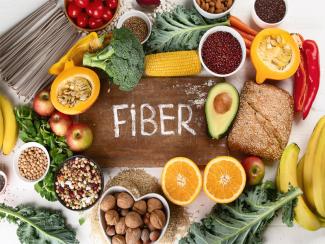Fiber and its role in your diet

The essential nutrient fiber can be easily overlooked when it comes to planning your meals. Most people only consider their vitamin intake, forgetting that there are other key nutritional components that have powerful effects on health. Fiber is known to be good for your heart, digestion, and gut microflora (it helps feed your friendly bacteria). It helps you feel fuller for longer, promotes a healthy weight, lowers cholesterol, aids and prevents constipation and diverticulosis and also helps control blood sugar levels. As a result it is not surprising that fiber-rich foods, like beans, lentils and peas, whole grains, vegetables, fruits, nuts, and seeds have been linked with so many health rewards. These include reduced risk of heart disease, obesity, diabetes, and certain types of cancers.
The Academy of Nutrition and Dietetics recommends 14 grams of fiber for every 1,000 calories per day, or, about 25 grams for women and 38 grams for men every day. Your exact needs may vary depending on your energy needs. Now, you must be wondering, how can I achieve this daily recommendation?
As mentioned, fiber can be found in plant-based foods. Eating the skin or peel of fruits and vegetables provides a greater dose of fiber. In addition to the sources noted above, here are some tips that can help you increase your fiber intake:
Increase beans. This is easy. Just add them to soups, salads, or instant pot recipes. This food group adds tons of fiber and more protein to the dish. I know that some readers might be concerned about the sodium level, so to reduce it you can rinse canned beans under running water.
Fill half of your plate with greens. This vegetable group is one of the richest out there in terms of in nutrients and the most often recommended for an increase. Both fruits and vegetables have high amounts of fiber, so this is why it’s beneficial to fill half of your plate with these foods.
Review your meal plan. To ensure you hit your fiber goal, ask yourself these questions:
- Could I add beans to this meal? Legumes are an excellent way to increase fiber, protein, and other key nutrients. They also increase satiety, keeping you satisfied longer.
- Can I add another vegetable?
- Did I have any fruits today with fiber such as: apples, pears, or oranges?
Eat real food. The less processed food you eat the more fiber you will ingest. If you are eating real food that is mostly unprocessed throughout the day you will have no problem hitting your goal.
Lastly, when increasing fiber, be sure to do it gradually and with plenty of fluids. As dietary fiber travels through the digestive tract, is like a new sponge; it needs water to plump up and pass smoothly. If you consume more than your usual intake of fiber but don’t drink enough fluid, you may experience nausea or constipation.
Lastly, enjoy! Fiber-rich roods are usually very tasty and satisfying.
